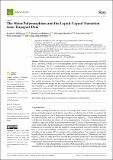| dc.contributor.author | Mallamace, Francesco | |
| dc.contributor.author | Chen, Sow-Hsin | |
| dc.date.accessioned | 2021-12-08T17:43:14Z | |
| dc.date.available | 2021-10-28T13:34:01Z | |
| dc.date.available | 2021-12-08T17:43:14Z | |
| dc.date.issued | 2021-08-25 | |
| dc.identifier.issn | 2673-7167 | |
| dc.identifier.uri | https://hdl.handle.net/1721.1/136692.2 | |
| dc.description.abstract | NMR spectroscopic literature data are used, in a wide temperature-pressure range (180–350 K and 0.1–400 MPa), to study the water polymorphism and the validity of the liquid–liquid transition (LLT) hypothesis. We have considered the self-diffusion coefficient <inline-formula><math xmlns="http://www.w3.org/1998/Math/MathML" display="inline"><semantics><msub><mi>D</mi><mi>S</mi></msub></semantics></math></inline-formula> and the reorientational correlation time <inline-formula><math xmlns="http://www.w3.org/1998/Math/MathML" display="inline"><semantics><msub><mi>τ</mi><mi>θ</mi></msub></semantics></math></inline-formula> (obtained from spin-lattice <inline-formula><math xmlns="http://www.w3.org/1998/Math/MathML" display="inline"><semantics><msub><mi>T</mi><mn>1</mn></msub></semantics></math></inline-formula> relaxation times), measured, respectively, in bulk and emulsion liquid water from the stable to well inside the metastable supercooled region. As an effect of the hydrogen bond (HB) networking, the isobars of both these transport functions evolve with <i>T</i> by changing by several orders of magnitude, whereas their pressure dependence become more and more pronounced at lower temperatures. Both these transport functions were then studied according to the Adam–Gibbs model, typical of glass forming liquids, obtaining the water configurational entropy and the corresponding specific heat contribution. The comparison of the evaluated <inline-formula><math xmlns="http://www.w3.org/1998/Math/MathML" display="inline"><semantics><msub><mi>C</mi><mrow><mi>P</mi><mo>,</mo><mi>c</mi><mi>o</mi><mi>n</mi><mi>f</mi></mrow></msub></semantics></math></inline-formula> isobars with the experimentally measured water specific heat reveals the full consistency of this analysis. In particular, the observed <inline-formula><math xmlns="http://www.w3.org/1998/Math/MathML" display="inline"><semantics><msub><mi>C</mi><mrow><mi>P</mi><mo>,</mo><mi>c</mi><mi>o</mi><mi>n</mi><mi>f</mi></mrow></msub></semantics></math></inline-formula> maxima and its diverging behaviors clearly reveals the presence of the LLT and with a reasonable approximation the liquid–liquid critical point (LLCP) locus in the phase diagram. | en_US |
| dc.publisher | Multidisciplinary Digital Publishing Institute | en_US |
| dc.relation.isversionof | http://dx.doi.org/10.3390/physchem1020014 | en_US |
| dc.rights | Creative Commons Attribution | en_US |
| dc.rights.uri | https://creativecommons.org/licenses/by/4.0/ | en_US |
| dc.source | Multidisciplinary Digital Publishing Institute | en_US |
| dc.title | The Water Polymorphism and the Liquid–Liquid Transition from Transport Data | en_US |
| dc.type | Article | en_US |
| dc.identifier.citation | Physchem 1 (2): 202-214 (2021) | en_US |
| dc.contributor.department | Massachusetts Institute of Technology. Department of Nuclear Science and Engineering | |
| dc.relation.journal | Physchem | en_US |
| dc.identifier.mitlicense | PUBLISHER_CC | |
| dc.eprint.version | Final published version | en_US |
| dc.type.uri | http://purl.org/eprint/type/JournalArticle | en_US |
| eprint.status | http://purl.org/eprint/status/PeerReviewed | en_US |
| dc.date.updated | 2021-08-26T13:29:16Z | |
| dspace.date.submission | 2021-08-26T13:29:16Z | |
| mit.journal.volume | 1 | en_US |
| mit.license | PUBLISHER_CC | |
| mit.metadata.status | Authority Work Needed | en_US |
